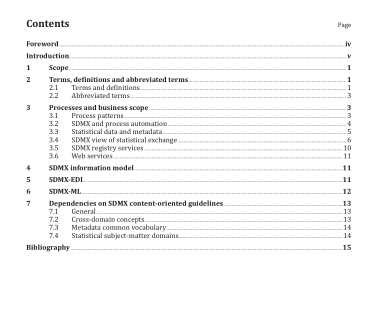BS ISO 17369:2013 pdf download.Statistical data and metadata exchange (SDMX)
3.1 Process patterns SDMX identifies three basic process patterns relevant to the exchange of statistical data and metadata. These can be described as follows.
a) Bilateral exchange: All aspects of the exchange process are agreed between two counterparties, including the mechanism for exchange of data and metadata, the formats, the frequency or schedule, and the mode used for communications regarding the exchange. This is perhaps the most common process pattern.
b) Gateway exchange: Gateway exchanges are an organized set of bilateral exchanges, in which several data and metadata collecting organizations or individuals agree to exchange the collected information with each other in a common format, and according to a common process. This pattern obviates the need for managing multiple bilateral exchanges (in data and metadata collection) across the sharing organizations/individuals. This is also a very common process pattern in the statistical area, where communities of institutions agree on ways to gain efficiencies within the scope of their collective responsibilities.
c) Data-sharing exchange: Data sharing is a mode of exchange where any party which is granted access to the data can obtain it in a known format, along with all relevant metadata, so as to be able to use the data without any prior arrangement with the data provider. Such use can be programmatic in nature, requiring a high degree of standardization both of data and metadata formats and content. It is also typical of a data-sharing scenario that the data be easy to locate, using an online catalogue or registry, although this is not an absolute requirement. In data-sharing mode, the differences between reporting data and disseminating data begin to disappear, i.e. a collector of data simply accesses it and downloads the needed data, much like any other user of the data.
The SDMX standards are designed to support any of the three exchange patterns mentioned. It is possible to use SDMX-EDI or SDMX-ML as a metadata-rich exchange format for bilateral reporting or gateway exchange; it is also possible to use the SDMX formats, web services guidelines and registry specification to fully support a data-sharing pattern. The design of SDMX is such that not all of the offered features need to be used: SDMX standards span the breadth between the use of the standard to provide a simple data and metadata format, through to a fully automated and standardized exchange of data in a data- sharing mode. The standards specified here specifically support a data-sharing process pattern based on the use of central registry services. Registry services provide visibility into the data and metadata existing within the community, and support the access and use of this data and metadata by providing a set of triggers for automated data and metadata retrieval. The data or metadata itself is not stored in a central registry: these services merely provide a useful set of metadata about the data (and additional metadata) in a known location, so that users/applications can easily locate and obtain whatever data and/or metadata are registered.
The use of standards for all data, metadata and the registry services themselves is ubiquitous, permitting a high level of automation within a data-sharing community. These three process patterns are not mutually exclusive: a single system capable of expressing data and metadata in SDMX-conformant formats could support all three patterns. In addition to looking at collection and reporting, it is also important to consider the dissemination of data. Data and metadata (no matter how they are exchanged between counterparties in the process of their development and creation) are all eventually supplied to an end user of some type. Often, this is through specific applications inside of institutions. However, more and more frequently, data and metadata are also published on websites in various formats. The dissemination of data and its accompanying metadata on the web is a focus of the SDMX standards. Standards for statistical data and metadata allow improvements in the publication of data: a standard format facilitates the linking of data to metadata, making the data more comprehensible to the end user and making further processing of the data easier. In discussions of statistical data, there are many aspects of its dissemination which impact data quality: data discovery, ease of use and timeliness. SDMX standards provide support for all of these aspects of data dissemination.
Standard data formats promote ease of use and provide links to relevant metadata. The concept of registry services means that data and metadata can more easily be discovered. Timeliness is improved throughout the data lifecycle by increases in efficiency, promoted through the availability of metadata and ease of use. Even though SDMX is primarily focused on the exchange and dissemination of statistical data and metadata, the standard is also applicable in the context of internal processing of data that are not concerned with the exchange between organizations and users. 3.2 SDMX and process automation Statistical data and metadata exchanges employ many different automated processes, but some are of more general interest than others. There are some common information technologies that are nearly ubiquitous within information systems today. SDMX aims to provide standards that are most useful for these automated processes and technologies.BS ISO 17369 pdf download.ISO 17369-2013 pdf download
